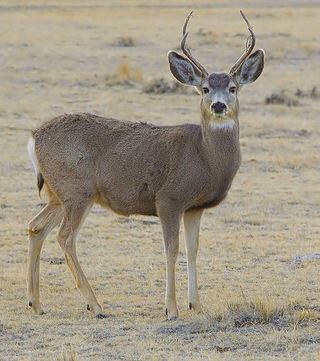
Author: Yathin S Krishnappa
Mule deer
Order : Artiodactyla
Family : Cervidae
Subfamily : Capreolinae
Species : Odocoileus hemionus
Keywords: white , black , tail
The Black-tailed deer, mule deer is listed as Least Concern (LR/lc), lowest risk. Does not qualify for a more at risk category. Widespread and abundant taxa are included in this category, on the IUCN Red List of Threatened Species
Namings for the mule deer
A young / baby of a mule deer is called a 'fawn or ass'. The females are called 'doe, hind or cow' and males 'buck, stag or bull'. A mule deer group is called a 'herd'.Mule deer habitats
Subarctic forestSome facts about the
Mule deer
Adult weight : 57 kg (125.4 lbs)
Maximum longevity : 22 years
Female maturity :478 days
Male maturity : 503 days
Gestation : 207 days
Weaning : 132 days
Litter size : 2
Litters per year : 1
Interval between litters : 365 days
Weight at birth : 2.95 kg (6.49 lbs)
Weight at weaning : 23.1 kg (50.82 lbs)
Facts about the mule deer
Physical Characteristics: Odocoileus hemionus is a medium-sized deer.
The Colorado River way down the canyon is responsible for carving up these rocks Mule deers are protected and flourish in the park
The extracted retropharyngeal lymph node from white-tailed deer (Odocoileus virginianus) or mule deer (Odocoileus hemionus) is added to the membrane of a 96-well filter plate.
The mule deer (Odocoileus hemionus) is frequently seen.
The Mule Deer is slower and less colorful than the White-tailed Deer, but its pastel, gray-buff color provides a physical adaptation to the desert environment which disguises it from predators like the Cougar, the Coyote and the eagle who will swoop down on a fawn.
Food Habits: Odocoileus hemionus is a small ruminant with limited ability to digest highly fibrous roughage (Short 1981). (Full text)
Hunting for desert mule deer is done mostly on foot since it is usually not feasible to use horses or pack animals. (Full text)
While unable to detect motionless objects, mule deers are extraordinarily sensitive to moving objects. (Full text)
The mule deer (Odocoileus hemionus) is a flashy newcomer on the North American scene, a descendant of the successful old-timer, the white-tailed deer. (Full text)
Mule deer is the only species that is set up for an outfitter drawing. (Full text)
by Derek Schmidt In Saskatchewan, the draw system for mule deer is for residents only. (Full text)
With its larger feet the Mule Deer is able to claw out water as much as 2 feet deep, which it detects with the keen sense of smell. (Full text)
The mule deer is noted for its peculiar, high-bouncing gait. (Full text)
Mule Deer The Mule Deer (Odocoileus hemionus) is an unexpected, but very common resident of the Refuge. (Full text)
More animals beginning with M
